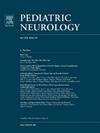Alice in Wonderland Syndrome in Children With Severe Acute Respiratory Syndrome SARS-CoV-2 Infection: A Case Series of Two Patients in an Italian Hospital
IF 3.2
3区 医学
Q2 CLINICAL NEUROLOGY
引用次数: 0
Abstract
Background
Alice in Wonderland syndrome (AIWS) is a disorienting neurological condition that affects human perception to the senses of vision, hearing, touch, and sensation and the phenomenon of time. Herein we report two pediatric cases of AIWS temporally related to severe acute respiratory syndrome coronavirus 2 (SARS-CoV-2) infection.
Case presentation
An eight-year-old-girl without history of migraine or epilepsy experienced some episodes of visual distortions (micropsia, macropsia, and teleopsia) and misperception of sound, sometimes associated with headache. The onset of symptoms began at the occurrence of fever (38°C), during SARS-CoV-2 infection. Another six-year-old girl, with no history of migraine or epilepsy, experienced short-term episodes of visual (metamorphopsia) and color disturbance (chromatopsia), during an otherwise asymptomatic SARS-CoV-2 infection. In both cases, clinical examination was unremarkable; surface electroencephalography showed normal findings, without any correlation between visual phenomena and cortical activity; and brain magnetic resonance was normal. The patients were given symptomatic treatment, consisting of anti-inflammatory drugs on demand. The frequency of episodes decreased progressively following a negative SARS-CoV-2 test, with full remission in a few weeks. At the moment of hospital admission, none of the patients had completed the two-dose vaccination schedule for SARS-CoV-2.
Conclusion
Based on our clinical experience, we believe SARS-CoV-2 may be responsible for AIWS, in addition to other neurological symptoms more frequently documented in the literature. Pathogenesis is multifactorial and arises from the activation of inflammatory pathways. We therefore suggest also searching for SARS-CoV-2, among other viruses linked with AIWS, in children presenting with visual and/or auditory hallucinations, even as isolated symptoms.
严重急性呼吸综合征 SARS-CoV-2 感染儿童的爱丽丝梦游仙境综合征:意大利一家医院两名患者的病例系列。
背景介绍爱丽丝梦游仙境综合征(Alice in Wonderland Syndrome,AIWS)是一种神经迷失症,会影响人的视觉、听觉、触觉、感觉和时间现象。在此,我们报告了两例与严重急性呼吸系统综合征冠状病毒 2(SARS-CoV-2)感染在时间上相关的儿童 AIWS 病例:病例介绍:一名八岁女孩,无偏头痛或癫痫病史,出现过一些视觉扭曲(小视、大视野和远视)和声音错觉,有时伴有头痛。这些症状是在感染 SARS-CoV-2 期间发烧(38°C)时开始出现的。另一名六岁女孩没有偏头痛或癫痫病史,在感染 SARS-CoV-2 期间出现了短期的视觉(偏视)和颜色障碍(色觉)。两例患者的临床检查均无异常;表面脑电图显示正常,视觉现象与大脑皮层活动之间无任何关联;脑磁共振检查正常。患者接受了对症治疗,包括按需服用抗炎药物。SARS-CoV-2 检测呈阴性后,发病频率逐渐减少,几周后完全缓解。入院时,所有患者均未完成两剂 SARS-CoV-2 疫苗接种:根据我们的临床经验,我们认为除了文献中更常见的其他神经系统症状外,SARS-CoV-2 也可能是导致 AIWS 的原因。发病机制是多因素的,源于炎症通路的激活。因此,我们建议在出现视觉和/或听觉幻觉(即使是孤立的症状)的儿童中也要寻找 SARS-CoV-2,以及其他与 AIWS 相关的病毒。
本文章由计算机程序翻译,如有差异,请以英文原文为准。
求助全文
约1分钟内获得全文
求助全文
来源期刊

Pediatric neurology
医学-临床神经学
CiteScore
4.80
自引率
2.60%
发文量
176
审稿时长
78 days
期刊介绍:
Pediatric Neurology publishes timely peer-reviewed clinical and research articles covering all aspects of the developing nervous system.
Pediatric Neurology features up-to-the-minute publication of the latest advances in the diagnosis, management, and treatment of pediatric neurologic disorders. The journal''s editor, E. Steve Roach, in conjunction with the team of Associate Editors, heads an internationally recognized editorial board, ensuring the most authoritative and extensive coverage of the field. Among the topics covered are: epilepsy, mitochondrial diseases, congenital malformations, chromosomopathies, peripheral neuropathies, perinatal and childhood stroke, cerebral palsy, as well as other diseases affecting the developing nervous system.
 求助内容:
求助内容: 应助结果提醒方式:
应助结果提醒方式:


